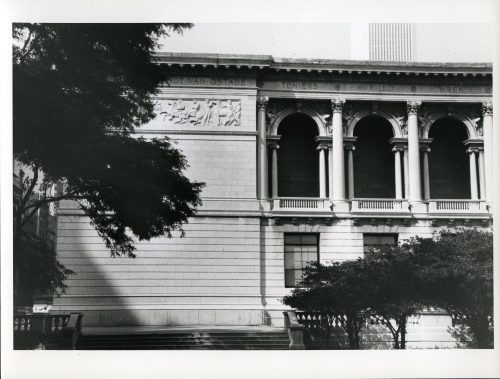BY ROBIN WYLLY MCCOWN
In the art world, names are everything—at least that is what the 1892-1893 Board of Trustees of the Art Institute of Chicago believed.
Hence, the handsomely etched and chronologically arranged names of painters, sculptors, and architects that run around the north, west, and south side friezes of the museum.
This original handwritten list of names (soon to be featured at the top of the new building) was penned by one of the trustees, and no doubt, was a ‘wish list’ featuring the names of history’s most important artists, as early as the 3rd Century BC.
The founding trustees of the Art Institute of Chicago were made up of venerable men who individually and collectively were behind the beginning of what would become one of the greatest institutions in the world. With foresight and wisdom, they hired the firm of Shepley Rutan & Coolidge to design the architecturally resplendent museum, completed in 1893.
The carving of names into a classical building’s frieze (part of the building’s entablature) dates to Roman times—no better example than the iconic Pantheon. In the Beaux-Arts tradition of 19th century America, inscribing names of the grandees of art and architecture was a way to pay homage while connecting the structure to its classical roots.
The artistic and sculptural embellishments on the building façade, executed out of Bedford limestone, made known the true purpose and meaning of this important new building.
This handsome structure would become regarded as Chicago’s new “Temple of Culture” on the shore of Lake Michigan and a monument to the dedication of the men who oversaw its execution.
The academic style, the Italian Renaissance design, was to be a statement for an enduring institution as well as a symbol of ancient authority on Western classical culture.
It is interesting to note the ultimate ‘typo’ on the left façade of the entrance to the museum. Michelangelo is actually one name, not two. As etched it reads: Michael Angelo.
The brilliant placement of the names in classic Times New Roman text was an addition that seemed to reflect the director’s and trustees’ ideas about art collection, display, and order.
Of all of the artists whose names are etched in stone, the Art Institute owns at least one work by Phidias, Fra Angelico, Memling, Botticelli, Durer, Raphael, Del Sarto, Correggio, Holbein, Veronese, Rubens, Velasquez, Van Dyck, Rembrandt, Van Ostade, Teniers, Hobbema, Reynolds, Gainsborough, Murillo, Turner, and Michelangelo. Artist names whose work is still on the ARTIC’s ‘wish’ list include Ictinus, Praxiteles, Apelles, Cimabue, Giotto, Ghiberti, Brunelleschi, Donatello, DaVinci, Van Eyck, Titian, Tintoretto, Wren, and Kanaoka.
The handsome inscriptions beautifully adorn this stellar institution. Look up and ‘frieze’ on your next visit.














